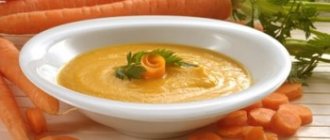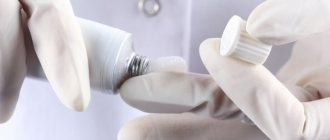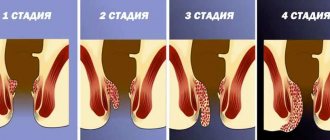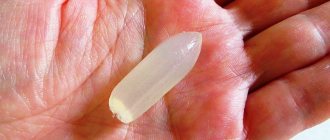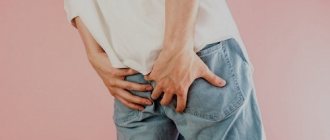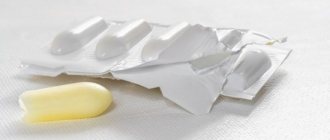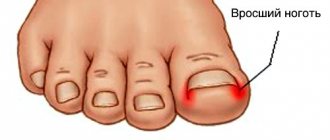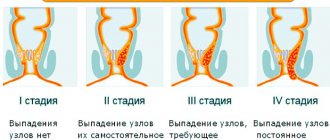Diet for hemorrhoids in women
Hemorrhoidal dilatation of the veins of the rectum appears when women have the following risk factors:
- hereditary weakness of the venous walls;
- habitual constipation;
- excess body weight;
- sedentary lifestyle, especially with prolonged sedentary work;
- inflammatory processes in the pelvic organs - colitis, salpingitis, cystitis, endometritis;
- dysbacteriosis;
- liver diseases;
- use of drugs for high blood pressure, vasodilators.
There are also nutritional causes of impaired outflow from the venous plexuses of the intestine. Most often, patients with hemorrhoids eat high-calorie, fatty foods; their menu is replete with meat and devoid of fresh vegetables and fruits.
In such cases, persistent constipation occurs, increasing pressure in the vasculature of the pelvis, which leads to dilation of the veins and stagnation of blood in them. If you have at least one of the risk factors and eat a lot of unhealthy food, the development of hemorrhoids becomes almost inevitable.
Nutrition helps to avoid this disease and its complications (bleeding, inflammation, pinched node, acute thrombosis). It involves the exclusion of foods that cause a rush of blood to the intestines, inhibiting its seduction. The diet uses mainly plant foods, fresh fermented milk drinks, and boiled fish. A prerequisite is a sufficient supply of clean drinking water.
Drinking regime
Drinks allowed are nectars, juices, fruit drinks, compotes, tinctures from the stems of medicinal herbs and fruit teas. The daily water requirement is 1.5 liters. Low alcohol drinks are allowed only during the period of remission and no more than 50 ml per day. The main advantage of water is its immediate penetration into the intestines. It softens feces well, restores the immune function of the intestines and flushes out fecal residues from the folds of the digestive organs. In this case, you need to remember:
- 350 ml of warm water on an empty stomach is the best remedy for constipation;
- cold water irritates the gastric mucosa, so it is better to replace it with infusions of chamomile flowers, raspberry root and sage leaves;
- lightly salted water promotes painless bowel cleansing; for 1 liter of settled water - a teaspoon of salt;
- mineral water heated to 40 degrees relaxes the intestinal walls, and cold water activates intestinal motility;
- dill water relieves symptoms of dysbiosis, and lemon water slows down inflammatory processes in the anus.
Rowan juice can be replaced with tinctures from the fruits of the same plant. For 400 g of peeled berries, take 2 liters of water. The drink is infused for 3 weeks and consumed warm. The course of treatment is 60 ml 3 times a day before meals for 7-10 days.
If the patient is not allergic to red foods and does not suffer from kidney failure, raspberry juice can be consumed. In the treatment of hemorrhoids, brewed roots, stems and leaves of the fragrant perennial help well. And since raspberries renew red blood cells in connective tissue, the possibility of anemia at the third stage of hemorrhoids does not exceed 5%.
Green tea is good for strengthening the walls of the anal veins. However, abuse of this drink can lead to an exacerbation of the disease. Therefore, you should consume no more than 450 ml of the product per day with minimal fermentation of the leaves.
Indications for prescribing nutritional therapy
Diet for hemorrhoids in women is recommended:
- with a congenital predisposition to the disease, the presence of other risk factors;
- at the initial stage of the disease;
- during exacerbation in combination with medications;
- for prevention during pregnancy;
- after surgical treatment - removal of nodes, ligation, laser coagulation.
Proper nutrition during pregnancy is of particular importance. At this time, the pressure of the enlarging uterus on the pelvic organs increases. Hormones produced by the placenta help relax smooth muscles. As a result, the risk of hemorrhoids increases manifold in women. If in the first months it most often manifests itself as discomfort during bowel movements, moderate pain, then in the later stages the untreated disease becomes severe.
The use of medications during pregnancy is always accompanied by the risk of adverse effects on the fetus. Therefore, nutrition is the main way to normalize the functioning of the digestive organs, prevent constipation and expansion of the venous network in the rectum.
Features of the diet for hemorrhoids for women
The purpose of prescribing a therapeutic diet is to stimulate bowel emptying due to mechanical stimuli (plant fibers, volume of food, liquid), temperature (cold drinks), as well as chemical ones - products with a laxative effect.
Nutrition rules
Basic principles of diet therapy:
- a sufficient amount of water, table salt, proteins, vegetable dishes, fresh fruits, herbs;
- inclusion of vegetable fats, replacement of animal parts with them;
- eating 5 times a day (optimally at the same time), long breaks are unacceptable, since the very intake of food activates intestinal contractions;
- when preparing vegetable dishes, you should not chop them too finely; purees and pureed soups inhibit the functioning of the intestinal wall;
- Salads of fresh vegetables and herbs seasoned with sunflower or olive oil should be a mandatory component of the diet at least 2 times a day. In addition to tomatoes and cucumbers, beets, zucchini, pumpkin, cauliflower, and carrots are eaten raw;
- juices are recommended freshly prepared with pulp;
- Soaked dried fruits (figs, dried apricots, prunes) are added to porridge and cottage cheese.
What to give up
Remove from the diet:
- hot pepper, daikon, radish, mustard, horseradish;
- sauces and herbs;
- white rice, refined flour, semolina, mashed potatoes, premium pasta;
- jellied meat, strong brews;
- lamb, duck, fatty pork, poultry skin, semi-finished products, lard, cooking oil;
- sausages, canned food;
- jelly, strong tea, alcohol;
- fermented milk drinks, if more than 3 days have passed since their preparation;
- hard boiled eggs;
- blueberries, persimmons, unripe pears and bananas.
Sample menu and recipes for hemorrhoids
When compiling a diet, you can use the following sample menu:
- fig compote (glass) on an empty stomach or cool water with a tablespoon of honey;
- oatmeal with pumpkin, apples and cinnamon, rosehip infusion;
- cottage cheese cookies with bran, yogurt;
- vegetable soup, boiled fish, tomato and basil salad;
- raw carrot salad, nuts, herbal tea;
- vegetable cabbage rolls, rye bread with Adyghe cheese;
- yogurt with bran and prunes.
Curd cookies with bran
These cookies are low in calories and are convenient to take with you for a snack.
Required:
- wheat or oat bran,
- cottage cheese 2% fat – 250 g,
- egg – 2 pieces (or mashed 1 banana),
- starch (preferably corn) – 4 tablespoons,
- stevia – 4 tablets,
- vanilla sugar – 5 g,
- cinnamon - teaspoon,
- raisins – 20 g.
Pour boiling water over raisins, dissolve stevia in a tablespoon of water. Rub the cottage cheese through a sieve, mix with eggs or banana pores, add cinnamon, vanillin and raisins. Mix with bran and starch. Place cookies by the tablespoon onto a greased baking sheet or silicone mat. Cook for 30 minutes at 180 degrees.
Vegetable cabbage rolls
This dish tastes practically no different from the traditional one, but has a stimulating effect on the functioning of the intestines.
It requires the following ingredients:
- cabbage – 1 small head,
- buckwheat – 2/3 cup,
- carrots – 2 pieces,
- onions – 2 pieces,
- greens - one large bunch of a mixture of dill and parsley,
- bell pepper – 2 pieces,
- tomato paste – 3 tablespoons,
- sunflower oil - a tablespoon,
- salt to taste.
First, you need to cut the stalk from a whole head of cabbage and make small cuts near the resulting hole. The head of cabbage treated in this way is placed in boiling water for 5 minutes. Then you need to cool the cabbage a little by dousing it with cold water and disassemble it into leaves. Instead of boiling, place it in the microwave for 7 minutes (maximum power), and then take it apart and once again bring the finished leaves to softness for 5 minutes.
To prepare the minced meat, boil the buckwheat for 15 minutes (the ratio of cereals and water is 1:2), cut the peppers and carrots into strips, and cut the onions into half rings. Vegetables are stewed in a frying pan with oil added. Half of the roast is mixed with buckwheat and finely chopped herbs, salted to taste.
Rough parts are cut out of the leaves or beaten with a hammer. Wrap the cabbage rolls and place them in layers in a deep pan. Pour 5 cm of salted water into the bottom. Cook until the cabbage becomes soft. The remaining half of the filling is mixed with tomato paste diluted with water (100 ml), poured over the cabbage rolls, and cooked for another 7 minutes. Turn off the heat and let it brew for about an hour.
What can you eat?
If inflammatory processes in the hemorrhoids progress, and anal fissures appear along with them, then foods high in dietary fiber should predominate on the menu.
An excellent solution would be to consume fiber from flax seeds daily. This is a good product that will allow food to be better absorbed. Fiber is sold at any pharmacy. Its cost does not exceed 100 rubles.
In addition to fiber from flax seeds, you can eat the following foods:
- Meat. The most beneficial will be lean meats. It is recommended to give preference to chicken, turkey, veal, lean beef, and rabbit.
- Fish. Almost all types of fish, even fatty ones, will be very useful if they are steamed or cooked in the oven.
- Vegetable broths. They can, and even should, be consumed daily. Moreover, vegetable broths should form the basis of the diet if a person has relatively recently undergone radical surgery.
- Fruits. These products will be useful. But there is one caveat. A person suffering from hemorrhoids and anal fissures can only eat non-acidic fruits.
- Seafood. Shrimp, crab, squid, mussels and other seafood are an excellent source of protein and healthy amino acids. They can be consumed daily, but in moderation.
- Walnuts. Of course, eating a lot of nuts is harmful. You can eat no more than 10-15 grams per day.
- Porridge and pasta made from durum wheat. Among the cereals, the most useful are oatmeal, buckwheat and wild rice.
- Fermented milk products. Preference should be given to fermented milk products with a low fat content. Cottage cheese (0-5%), low-fat yogurt (without flavoring agents), yogurt, whey, kefir, mild cheese will be useful.
- Rye bread and bran bread (in limited quantities).
What kind of sweets can I have? Unfortunately, most confectionery products are strictly prohibited for consumption. If you want something sweet, you can treat yourself to honey.
Medicines against hemorrhoids in women during pregnancy
At initial signs of discomfort during bowel movements, it is necessary to supplement the diet with external agents.
Proctosan suppositories for hemorrhoids
Suppositories relieve pain and burning thanks to the lidocaine they contain, reduce inflammation and swelling, and bismuth salts dry out and have an astringent effect. Proctosan is contraindicated during pregnancy. During this period, it is recommended to use drugs mainly from natural ingredients or with proven safety.
The following are allowed for pregnant women:
- sea buckthorn suppositories;
- calendula or arnica in the form of ointments for external hemorrhoids;
- Natalsid - candles based on seaweed.
Is Aurobin allowed during pregnancy?
The ointment contains a hormonal component - prednisolone, as well as analgesic, anti-inflammatory and healing components. This drug effectively relieves pain and burning, increases the tone of the venous walls, and relieves swelling of the tissues around the anus. Contraindications for use include the first trimester of pregnancy. At later stages, it is used for no more than 3 days. All medications should only be prescribed to women during pregnancy by a doctor. Self-medication is strictly prohibited.
Folk remedies for hemorrhoids after childbirth
For periodic node loss, you can use natural remedies. To do this, cut a candle from raw potatoes or chilled butter. It has approximately the same dimensions as the pharmacy ones - 3X1 cm. The resulting blocks are placed in the freezer overnight, and in the morning they are inserted into the anus.
For rinsing after each bowel movement, decoctions of anti-inflammatory herbs are used: oak bark, calendula, St. John's wort, yarrow, string. Prepare the herbal medicine at the rate of 2 tablespoons per 0.5 liter of water, boil for 15 minutes and filter. From the same decoction you can make ice cubes that are used to wipe the anal area.
You can find out what kind of gymnastics is needed for hemorrhoids from the video:
Why do you need a diet?
Proper nutrition is the key to a speedy recovery. The first step is to exclude foods that cause fermentation and flatulence from your diet. You should also reduce the consumption of fresh baked goods and almost all flour products that irritate the intestinal mucosa. It is better to replace them with dietary fiber, which normalizes the structure of the stool.
The main goal of the diet during an exacerbation of the disease is to improve gastrointestinal motility and thereby relieve pain during bowel movements. For this effect, experts advise cooking first courses with carrot broth. Cereals in soups need to be well boiled and rubbed through a sieve. It is better to steam meat dishes, especially cutlets and meatballs, and bake chicken in the oven without crust.
For appetizers, dietary salads made from boiled eggplants, as well as unsalted 20% cheese, are allowed. To prevent intestinal irritation, the temperature of first courses should not exceed 50 degrees. The optimal temperature for drinks is 18 degrees. Food should be liquid or mushy. At the same time, you need to remember: eating food too quickly contributes to diarrhea, which is dangerous due to dehydration. Slow movement of food, on the contrary, leads to constipation. In this case, feces decompose in the intestines, and the blood is saturated with toxins.
A healthy diet at any stage of hemorrhoids contributes to:
- restoration of motor, immune and excretory functions of the intestines;
- speedy healing of wounds in the anal area;
- easy bowel movements, and when eating dry cookies or low-fat pilaf - consolidation of the stool;
- improving the general condition of patients;
- increasing the elasticity of the vessels of the anus as a result of weight loss.
With this illness, it is useful to eat small portions 5-6 times a day. Preference is given to crushed products. In the postoperative period, it is important to reduce pressure on the intestinal walls. For this purpose, patients are prescribed fractional meals.
